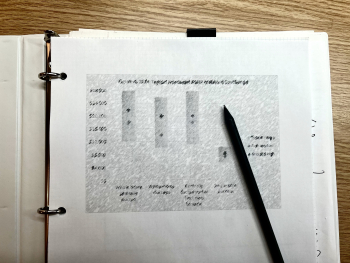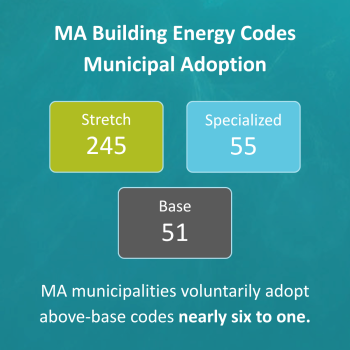

By Cornelia Wu | Thu, June 26, 25
You’ve probably heard this before: you can’t manage what you don’t measure. But you might not have heard that Massachusetts is measuring energy use and emissions in buildings with two new projects that can help manage costs and emissions. The Municipal Fossil Fuel Free Building Demonstration Program and Large Building Energy Reporting (LBER) were created in 2022 by An Act Driving Clean Energy and Offshore Wind. Both are reaching important public reporting milestones this year. NEEP is supporting the Massachusetts Department of Energy Resources (MA DOER) on both projects by developing reporting protocols and leading outreach and education to participating stakeholders and communities. Here is a status update on the projects.
Part One: Measure
Fossil Fuel Free for New Construction and Major Renovations
Ten municipalities in Massachusetts were selected to be part of the groundbreaking Fossil Fuel Free Building Demonstration Program. The demonstration program enables up to 10 municipalities to adopt ordinances or by-laws to require new construction and major renovation projects to be fossil fuel-free. New construction includes both residential and commercial buildings. Definitions for major renovation can be found in 225 CMR 24.00. These communities – Acton, Aquinnah, Arlington, Brookline, Cambridge, Concord, Lexington, Lincoln, Newton, and Northampton – will report data throughout the project. Several communities not participating in the demonstration project will serve as controls by reporting the same data for parallel time periods.
NEEP is working with technical partner, ClearlyEnergy, to configure the dataset in NEEP’s Home Energy Labeling Information eXchange (HELIX), which is uniquely suited for this purpose. MA DOER will analyze net reduction in emissions for new construction and major renovation projects in participating and control communities; assess impacts on housing production, housing affordability, electric bills, and heating bills; and evaluate the impacts on low-to-moderate income households. These reports will be filed by September 30, 2025 and every two years thereafter.
Benchmarking for Large Existing Buildings
Benchmarking is the process of measuring energy consumed by a building. Large Building Energy Reporting (LBER) is a mandatory statewide benchmarking policy applicable to Massachusetts buildings over 20,000 square feet. Utilities will report building energy data for electricity and gas, and owners must self-report data for fuel oil, propane, wood, and on-site solar generation. NEEP is working with ClearlyEnergy, this time using the Building Energy Analysis Manager (BEAM) platform, to gather and report data. MA DOER will publish energy use information and associated greenhouse gas emissions for each covered building, together with a comprehensive report using collected data by October 31, 2025 and every year thereafter.
For building owners, benefits of benchmarking include the ability to compare their building energy use to the average for their building type, and to reduce future energy costs by identifying potential efficiency improvements.
This spring, NEEP hosted three webinars for over 1,100 attendees to educate stakeholders and answer questions. The second and third webinars included live interpretation in seven languages plus American Sign Language. Webinar recordings and slide decks can be found on the Massachusetts LBER Knowledgebase.
Part Two: Manage
These two new programs, which focus on measuring energy and emissions in buildings, will help communities and building owners in the Commonwealth better manage their energy costs. Other programs in Massachusetts are already in effect to help manage energy costs, or are approaching implementation phases. These include building energy codes and performance standards.
Building Energy Codes
Massachusetts has three tiers of building energy code available to municipalities: the base energy code, the opt-in Stretch code (which was first adopted in 2009 and exceeds the requirements of the base code), and an opt-in Specialized code, adopted in 2022. The Specialized code was created to support the state goal of achieving net-zero greenhouse gas emissions from the buildings sector no later than 2050. However, the Specialized code does not eliminate the use of fossil fuels.
Communities that have voluntarily adopted an above-base code outnumber those using the base code by nearly six to one. As of June 2025, there are 51 municipalities using the base energy code, 245 using the Stretch code, and 55 using the Specialized code. All 10 communities participating in the Fossil Fuel Free program operate under the Specialized code.
Major code introductions and updates require attention and refinement to ensure successful implementation and effectiveness. Both the Stretch and Specialized codes have undergone public comment periods and subsequent updates, most recently in February 2025.
NEEP facilitates the Massachusetts Net Zero Buildings (MA NZB) Coalition, an assembly of elected and appointed municipal officials, building industry and design professionals, and non-profit organizations, with support from the Barr Foundation. With Coalition feedback, NEEP recently created this resource: Now is the Time for Communities to Update to the Massachusetts Stretch Code: A Deep Dive into the 10th Edition Base Code and the Stretch Code to assist municipalities in understanding the Stretch code and how it compares to the 10th edition base code.
Building Performance Standards
For large buildings, what are the options after benchmarking? Building Performance Standards (BPS) can be implemented by state or local governments to enhance building energy efficiency and reduce emissions in existing commercial and multifamily buildings. Boston, Cambridge, and Newton have already adopted BPS. Additional jurisdictions in Massachusetts are considering such policies. NEEP and ClearlyEnergy convened a virtual cohort of interested communities in Massachusetts and Rhode Island to cover topics such as BPS 101, Roles & Responsibilities, ENERGY STAR Portfolio Manager, and Legal Considerations. NEEP may convene a second cohort to include additional communities in the future.
What’s Next?
NEEP will be hard at work all summer tracking data to support Massachusetts’ efforts to measure building energy use and emissions. Is your building included in the LBER Covered Buildings List? If so, claim your building and consult the LBER Knowledgebase for more information. If you are interested in joining the MA NZB Coalition, visit this page and reach out to NEEP. Stay tuned for public reports to be submitted by MA DOER to the Massachusetts legislature in September 2025 for the Fossil Fuel Free Building Demonstration Program, and to be released by MA DOER in October 2025 for LBER.



